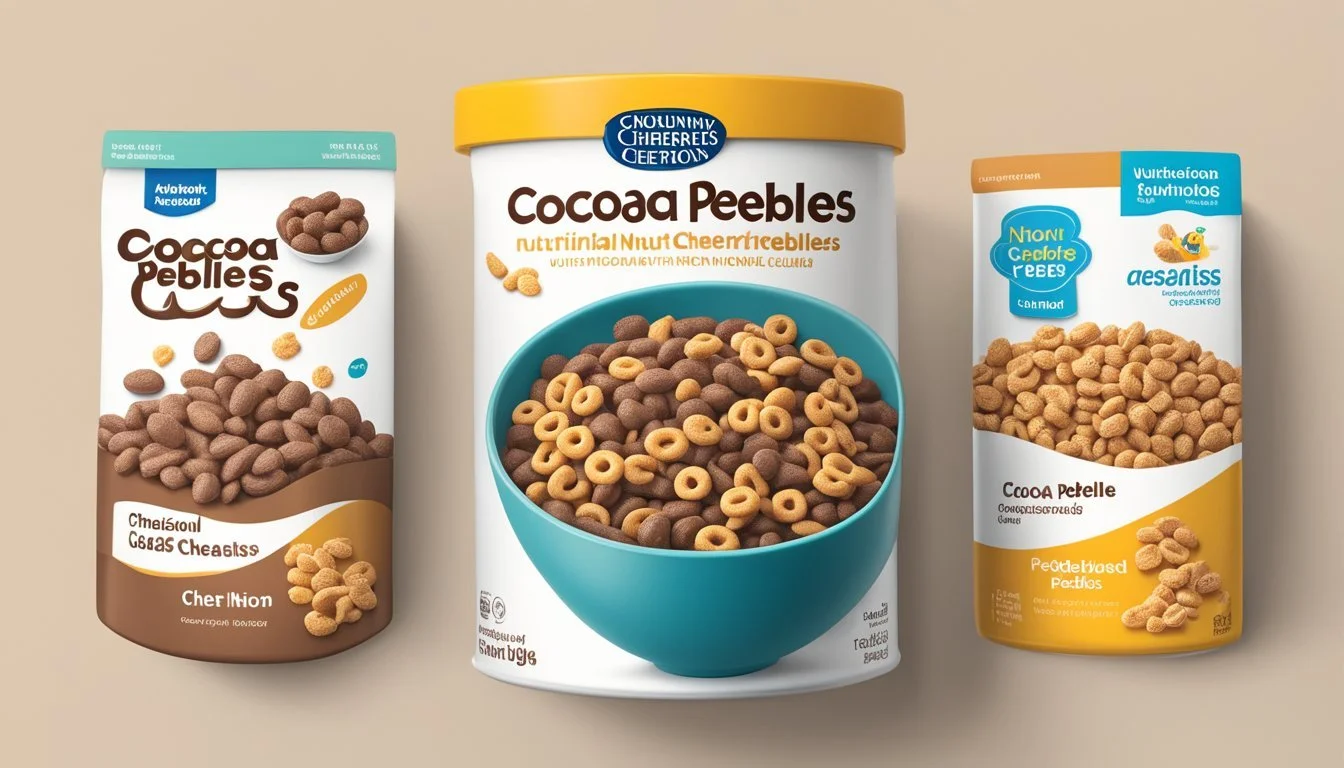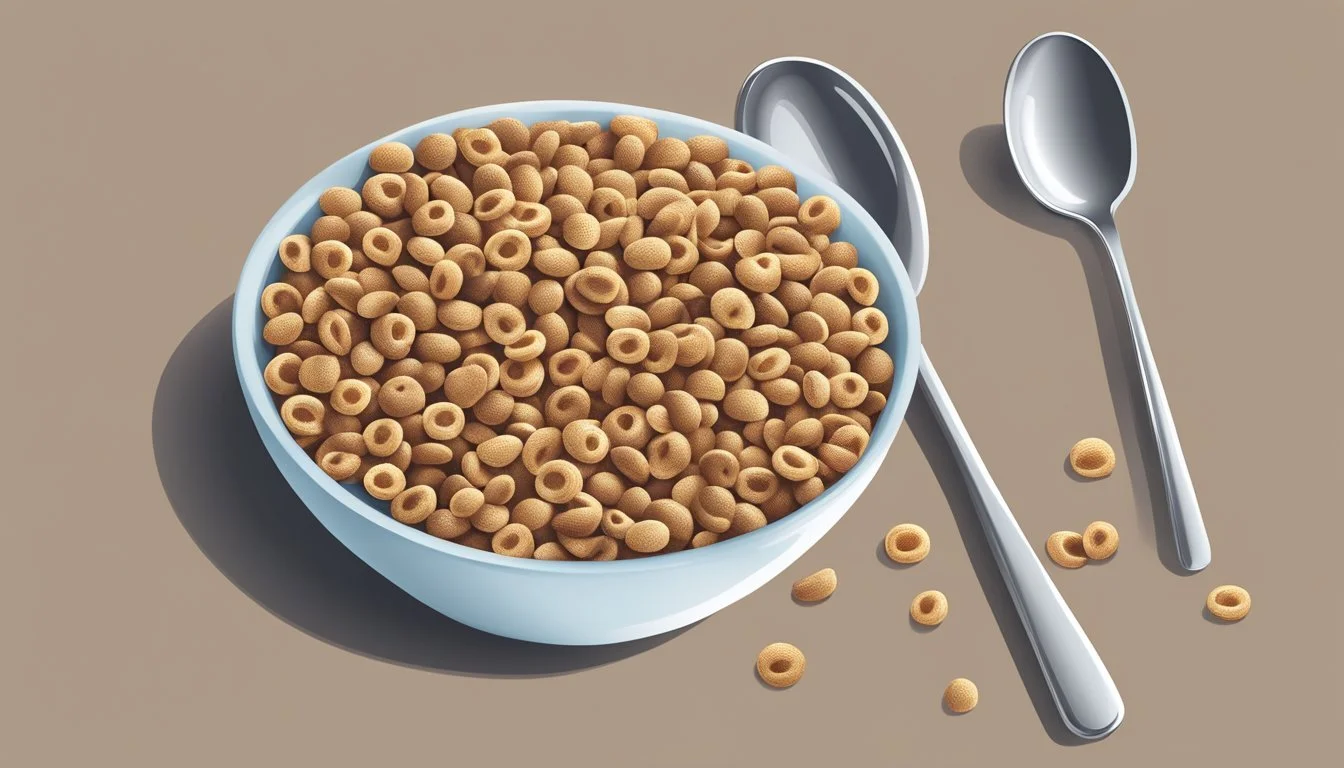Cocoa Pebbles vs Honey Nut Cheerios
A Nutritional and Taste Comparison
This Article is Part of Our Breakfast Cereal Guide with Details on Cocoa Pebbles Nutrition and Honey Nut Cheerios Nutrition
When it comes to choosing the right cereal, many find themselves debating between Cocoa Pebbles and Honey Nut Cheerios. Each offers a unique taste and nutritional profile, making the decision a bit challenging for cereal enthusiasts. Understanding the differences can help make the morning meal both enjoyable and healthy.
Cocoa Pebbles, with their rich chocolate flavor, have long been a favorite among those who enjoy a sweet breakfast treat. This cereal provides 140 calories and 31 grams of carbs per serving, making it a flavorful choice. Honey Nut Cheerios, on the other hand, offer a slightly lower caloric content at 110 calories per serving, along with a balance of 22 grams of carbs and 2 grams of fiber. This makes them an appealing option for those looking to add more fiber to their diet.
Nutritionally, the comparison highlights a clear distinction: Cocoa Pebbles cater to those with a sweet tooth, while Honey Nut Cheerios serve those in search of a more balanced, albeit still sweet, option. Each has its own merits depending on what one is looking for in their breakfast routine.
Comparative Overview of Cocoa Pebbles and Honey Nut Cheerios
When comparing Cocoa Pebbles and Honey Nut Cheerios, key nutritional differences arise.
Cocoa Pebbles contain 13.0 grams of complex carbohydrates per serving. Honey Nut Cheerios, by contrast, offer 11.5 grams of complex carbohydrates per serving.
The sugar content is another important metric. Cocoa Pebbles have 12 grams of sugar per serving, making them a sweeter option. Honey Nut Cheerios have less sugar, at 9 grams per serving, catering to those mindful of sugar intake.
In terms of calories, Cocoa Pebbles contain 140 calories per cup. Honey Nut Cheerios are slightly lower in calories, with 110 calories per three-quarter cup serving.
Fiber content plays a role in the nutritional profile. Honey Nut Cheerios have 2 grams of fiber per serving, which is double the fiber found in Cocoa Pebbles, which only contains 1 gram.
Additionally, the fat content is minimal in both cereals. Cocoa Pebbles have 1.5 grams of fat per serving, whereas Honey Nut Cheerios also have 1.5 grams of fat with no saturated fat.
Sodium content is slightly higher in Honey Nut Cheerios, with 160 mg per serving, compared to 150 mg in Cocoa Pebbles.
Here's a comparative snapshot:
Nutrient Cocoa Pebbles Honey Nut Cheerios Carbs 13.0g 11.5g Sugars 12g 9g Calories 140 110 Fiber 1g 2g Fat 1.5g 1.5g Sodium 150mg 160mg
Both cereals have their unique nutritional benefits and drawbacks. Families and individuals should consider their dietary needs and preferences when choosing between them.
Historical Background
Cocoa Pebbles and Honey Nut Cheerios each have their own unique heritage. Understanding when and how they were created provides insight into their development and popularization over time.
The Evolution of Cocoa Pebbles
Cocoa Pebbles, introduced by Post Consumer Brands in 1970, was one of the first chocolate-flavored cereals to capture the breakfast market. The cereal features a unique pebble-shaped design, derived from their association with The Flintstones, a popular cartoon.
Originally, both Cocoa Pebbles and its counterpart Fruity Pebbles were spun off from the character shapes of a previously existing Post cereal. The branding tie-in helped swiftly elevate Cocoa Pebbles into a household name. The cereal was designed to offer a chocolatey, crispy taste that appealed particularly to children.
Over the years, the formulation of Cocoa Pebbles has seen minimal changes. It continues to remain a favorite among chocolate cereal enthusiasts, with its simple ingredients and consistent flavor profile.
The Legacy of Honey Nut Cheerios
Honey Nut Cheerios, created by General Mills, entered the market in 1979. The cereal was conceptualized by Yandel Gonzalez, adding a touch of honey and almond flavoring to the original Cheerios. This gave it a slightly sweeter taste, which quickly gained a broad audience.
Initially, the product included real nuts, although this ingredient was removed in 2006 due to allergen concerns. BuzzBee, the mascot for Honey Nut Cheerios, was introduced around the same time, aiding in its market appeal.
Leveraging its parent brand's popularity, Honey Nut Cheerios quickly became a best-seller. Today, it remains one of the most popular cereal varieties in the world, credited with offering a more nutritious and heart-healthy breakfast option.
Nutritional Profile
Cocoa Pebbles and Honey Nut Cheerios offer different nutritional benefits. Cocoa Pebbles is higher in sugar but lower in fiber and protein, while Honey Nut Cheerios provides more fiber and some essential vitamins.
Nutritional Value in Cocoa Pebbles
Cocoa Pebbles, a chocolate-flavored cereal, tends to have a high sugar content, with approximately 14 grams per serving. It is generally low in fiber, often just about 1 gram per serving, which might not significantly contribute to daily fiber intake.
This cereal provides a moderate amount of protein, around 2 grams per serving. Vitamins and minerals like iron are added, but they are not as nutrient-dense compared to whole grain cereals.
While it’s not gluten-free, Cocoa Pebbles can be part of a balanced diet if consumed in moderation. However, its primary appeal is taste rather than nutrition.
Nutritional Value in Honey Nut Cheerios
Honey Nut Cheerios is known for a balanced nutritional profile, especially compared to many sugary cereals. With only 9 grams of sugar per serving, it is relatively lower in added sugars.
This cereal shines in its fiber content, offering about 2 grams per serving, which can aid digestion. Each serving also provides nearly 3 grams of protein, making it more satisfying.
It includes essential vitamins and minerals, such as iron and certain B vitamins, contributing to a well-rounded nutrient intake. Additionally, it’s made from whole grains, enhancing its nutrient density.
Though not gluten-free, Honey Nut Cheerios is often preferred for its health benefits and balanced nutrient profile.
Ingredients and Flavors
When comparing Cocoa Pebbles and Honey Nut Cheerios, it's crucial to examine both their ingredients and flavors. These aspects directly influence nutritional value and taste preferences.
Ingredients Comparison
Cocoa Pebbles:
Primarily made of rice, sugar, and hydrogenated vegetable oil.
Contains cocoa processed with alkali for the chocolate flavor.
Includes added vitamins and minerals such as iron and vitamin D.
Honey Nut Cheerios:
Made of whole grain oats and sugar.
Uses honey and almond flavoring to achieve its characteristic taste.
Fortified with a variety of vitamins and minerals, including calcium and zinc.
Similarities:
Both cereals include added sugars and fortifications.
Both utilize flavoring agents to enhance taste.
Differences:
Cocoa Pebbles rely on rice and cocoa, whereas Honey Nut Cheerios primarily use whole grain oats and honey.
The types of fats used differ, with Cocoa Pebbles including hydrogenated oils and Honey Nut Cheerios incorporating healthier oil versions.
Flavor Profiles
Cocoa Pebbles:
Offers a rich chocolate taste derived from its cocoa content.
Has a sweet, dessert-like flavor that appeals to chocolate lovers.
The texture is crispy and tends to soften quickly in milk.
Honey Nut Cheerios:
Features a light, honey-sweetened flavor with a hint of almond.
Generally perceived as a well-balanced mix of sweet and nutty undertones.
Maintains a crunchier texture in milk compared to Cocoa Pebbles.
Taste Considerations:
Cocoa Pebbles are more likely to appeal to those looking for a chocolate-flavored breakfast.
Honey Nut Cheerios might be preferred for a less sweet, slightly nutty flavor.
Understanding these differences can help consumers choose the cereal that best fits their taste and dietary preferences.
Cereal Varieties and Brand Expansion
Exploring the variety in cereals can help understanding the range of flavors and nutritional profiles. Several popular cereal brands offer multiple flavors to cater to diverse consumer tastes.
Variants of Cheerios
Cheerios, a staple from General Mills, comes in numerous flavors beyond the original. Popular variants include Honey Nut Cheerios, which adds a sweet, nutty twist. Chocolate Cheerios caters to chocolate lovers while maintaining the brand's whole grain benefits. Fruity Cheerios provides a mix that resembles other fruity cereals like Trix, though some find the flavor to taste artificial.
Multi Grain Cheerios offers a more health-conscious option, combining oats, corn, and rice for a balanced profile. For a twist on texture and flavor, there are also Cheerios Oat Crunch varieties, which include Oat 'N Honey and Cinnamon options. Each variant brings unique tastes and nutritional elements to suit different preferences.
Different Flavors of Pebbles Cereals
Pebbles cereals, primarily Fruity Pebbles and Cocoa Pebbles from Post Consumer Brands, are known for their vibrant colors and bold flavors. Fruity Pebbles packs a sugary, fruity punch and is often compared to Froot Loops or Trix in terms of flavor appeal. It's popular among kids for its bright, eye-catching appearance and distinct taste.
Cocoa Pebbles, on the other hand, offers a chocolate experience that competes with cereals like Cocoa Puffs and Chocolate Cheerios. These cereals not only provide the indulgent taste of chocolate but also turn milk into a chocolatey treat. Post occasionally releases limited editions and collaboration flavors to keep the brand fresh and exciting for consumers.
Pebbles cereals continue to expand their flavors to maintain interest in the market dominated by classic brands like Frosted Flakes, Lucky Charms, and Cap’n Crunch.
This diversification of flavors and continuous innovation helps both Cheerios and Pebbles cereals stay relevant in the competitive breakfast market.
Market Position and Popularity
Cocoa Pebbles and Honey Nut Cheerios occupy unique positions in the breakfast cereal market, each targeting different consumer segments with distinct selling points. Here’s a detailed look into their consumer preferences and sales trends.
Consumer Preferences
Honey Nut Cheerios, known for its heart-healthy claims, targets health-conscious adults and families. The cereal’s mild sweetness from honey and added nuts appeal to a broad demographic. Cheerios brand loyalty is strong, with health benefits often highlighted in advertising.
Cocoa Pebbles, on the other hand, is a favorite among children and those who enjoy chocolate-flavored cereals. It markets itself as a fun and indulgent breakfast option. The bright, colorful packaging and endorsements from popular cartoons make it particularly attractive to younger audiences.
Sales and Market Trends
Honey Nut Cheerios consistently ranks among the top-selling cereals. In recent data, it accounted for a significant portion of General Mills' U.S. cold cereal sales, highlighting its strong market presence. The cereal boasted sales of around 129.3 million boxes recently, generating significant revenue.
In contrast, Cocoa Pebbles has a substantial following but does not reach the same sales volume as Honey Nut Cheerios. The cereal remains popular in the kids' cereal segment but faces stiff competition from other chocolate-flavored options. Despite this, it has a dedicated consumer base that continues to drive steady sales.
Both cereals have maintained strong brand presence in the cereal aisle, but they serve distinct markets, leading to different sales dynamics and consumer base loyalty.
Health and Dietary Considerations
When evaluating the health and dietary aspects of Cocoa Pebbles and Honey Nut Cheerios, key factors include their sugar content, fiber levels, and nutritional benefits such as vitamins and minerals. Comparing these elements helps to understand their impact on a balanced diet.
Sugar and Health Discussions
Cocoa Pebbles and Honey Nut Cheerios both contain added sugar, a significant consideration for many consumers. Cocoa Pebbles can have high sugar levels, impacting overall health if consumed frequently. Honey Nut Cheerios also possess added sugars, although the amount per serving may be slightly lower compared to Cocoa Pebbles.
Excess sugar intake is linked to health issues like obesity and diabetes. Therefore, it's crucial to monitor sugar consumption from cereals, especially for children. Comparatively, cereals with high sugar content, classified as sugar cereals, should be moderated within a diet to prevent potential health risks.
Cereal as Part of a Balanced Diet
Cereals such as Cocoa Pebbles and Honey Nut Cheerios can fit within a balanced diet when consumed appropriately. Honey Nut Cheerios offer whole grain oats, which provide fiber and iron, contributing to a nutrient-dense breakfast choice. This cereal's emphasis on vitamins and minerals also supports a well-rounded diet.
Cocoa Pebbles, though flavorful, may lack some nutritional benefits found in Honey Nut Cheerios. It is essential to pair these cereals with other nutrient-rich foods, like fruits and dairy, to enhance breakfast value. Assessing cereal choices based on protein, fiber, and overall nutrient quality ensures a more comprehensive dietary plan.
Cereal in Popular Culture and Media
Cereal has a significant presence in popular culture, often highlighted through creative advertising campaigns and character branding. These strategies have shaped public perceptions and loyalty toward various cereal brands.
Advertising Campaigns
Cereal advertising campaigns have been instrumental in cementing their place in households. Cocoa Puffs is renowned for its energetic mascot, Sonny the Cuckoo Bird, whose catchphrase "I’m cuckoo for Cocoa Puffs!" has been a staple since the 1960s.
Honey Nut Cheerios also leveraged advertising by introducing the friendly character BuzzBee, who emphasizes the cereal's honey flavor. Campaigns often focus on the health benefits, such as Honey Nut Cheerios' ability to help reduce cholesterol.
Other cereals, like Frosted Mini-Wheats and Cinnamon Toast Crunch, have used memorable taglines and animated characters to create a lasting impression. Kix famously employed the slogan "Kid-tested, mother-approved," appealing to both children and parents.
Cereal and Character Branding
Character branding plays a crucial role in the cereal industry. Reese’s Puffs uses the appeal of the popular Reese's candy brand, infusing nostalgia and recognition. Frosted cereals like Frosted Mini-Wheats highlight frosted goodness with quirky characters that personify the mix of taste and nutrition.
Wheaties, known as "The Breakfast of Champions," features athletes on its boxes, connecting the cereal with sports legends. Cinnamon Toast Crunch showcases the "Crazy Squares," bringing a fun and mischievous life to its brand.
Cereals like Honeycomb and Waffle Crisp have periodically refreshed their mascots and characters to stay relevant to new generations. By leveraging icons and creative characters, brands maintain a strong presence in both traditional and digital media platforms.
Consumer Experience and Brand Loyalty
Both Cocoa Pebbles and Honey Nut Cheerios have cultivated devoted followings due to their unique taste profiles and engagement strategies.
Taste and Texture Feedback
Cocoa Pebbles offers a rich chocolate flavor that becomes more pronounced when mixed with milk. The cereal is characterized by its crisp texture, which turns into a satisfying crunch when eaten. An additional perk is the chocolate milk left behind, which many consumers love.
Honey Nut Cheerios, on the other hand, combines a subtle honey sweetness with the satisfying heartiness of oats. The texture remains consistently crunchier for longer than Cocoa Pebbles, making it a favorite for those who prefer less soggy cereal.
Cereal Flavor Profile Texture Experience Cocoa Pebbles Rich chocolate taste Crisp, turns crunchy with milk Honey Nut Cheerios Subtle honey sweetness Stays crunchy for longer
Loyalty Programs and Engagement
Cereal brands like Cocoa Pebbles and Honey Nut Cheerios utilize loyalty programs to keep consumers engaged. Cocoa Pebbles frequently offers promotions such as collectible toys and codes for digital rewards. Their presence on social media platforms also helps to foster a community around their brand.
Honey Nut Cheerios excels with its CheeriOats Rewards Program, providing points for purchases that can be redeemed for discounts or merchandise. The brand also emphasizes health-focused campaigns, which resonates with their audience and reinforces brand loyalty.
Cereal Loyalty Program Engagement Strategy Cocoa Pebbles Collectible toys, digital rewards Active social media presence Honey Nut Cheerios CheeriOats Rewards Program Health-focused campaigns
More on Cocoa Pebbles
More on Honey Nut Cheerios
Cinnamon Toast Crunch vs Honey Nut Cheerios: Which is better?
Honey Nut Cheerios vs Kellogg's Apple Jacks: Which is better?
Honey Nut Cheerios vs Kellogg's Froot Loops: Which is better?
Honey Nut Cheerios vs Post GrapevsNut Flakes: Which is better?
Honey Nut Cheerios vs Post Raisin Bran Cereal: Which is better?





